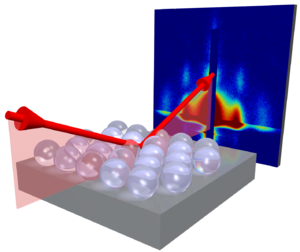Difference between revisions of "GISAXS"
KevinYager (talk | contribs) (Created page with "'''Grazing-Incidence Small-Angle X-ray Scattering''' ('''GISAXS''') is a surface-sensitive scattering technique used to probe the nanostructure of thin films. ==See Also=...") |
KevinYager (talk | contribs) |
||
| Line 1: | Line 1: | ||
'''Grazing-Incidence Small-Angle X-ray Scattering''' ('''GISAXS''') is a surface-sensitive [[scattering]] technique used to probe the nanostructure of thin films. | '''Grazing-Incidence Small-Angle X-ray Scattering''' ('''GISAXS''') is a surface-sensitive [[scattering]] technique used to probe the nanostructure of thin films. | ||
| + | It is a versatile and powerful technique, which enables studies of nanoscale objects deposited on surfaces (e.g. nanoparticles), thin and ultra-thin layers of nanomaterials (e.g. [[block-copolymers]]), or nano-structured surfaces (e.g. lithographic patterns). | ||
| + | |||
| + | ==Experiment== | ||
| + | A typical GISAXS experiment involves directing a focused and collimated [[x-ray ]] beam towards the surface of a thin film supported on a flat substrate. The grazing-incidence angle is carefully controlled using a sample-tilt stage, and is typically on the order of 0.05° to 0.50°. At these shallow angles, the x-ray beam is efficiently reflected off the sample and/or substrate surfaces. The beam interacts with the sample's structure, giving rise to scattering features (peaks, rings, etc.) that encode the nanoscale order in the sample. | ||
| + | |||
| + | [[Image:Gisaxs logo01.png|300px|center]] | ||
| + | |||
==See Also== | ==See Also== | ||
* [http://en.wikipedia.org/wiki/Grazing-incidence_small-angle_scattering Wikipedia: Grazing-incidence small-angle scattering] | * [http://en.wikipedia.org/wiki/Grazing-incidence_small-angle_scattering Wikipedia: Grazing-incidence small-angle scattering] | ||
* [[GTSAXS]] | * [[GTSAXS]] | ||
* [[GIWAXS]] | * [[GIWAXS]] | ||
Revision as of 20:26, 29 September 2014
Grazing-Incidence Small-Angle X-ray Scattering (GISAXS) is a surface-sensitive scattering technique used to probe the nanostructure of thin films.
It is a versatile and powerful technique, which enables studies of nanoscale objects deposited on surfaces (e.g. nanoparticles), thin and ultra-thin layers of nanomaterials (e.g. block-copolymers), or nano-structured surfaces (e.g. lithographic patterns).
Experiment
A typical GISAXS experiment involves directing a focused and collimated x-ray beam towards the surface of a thin film supported on a flat substrate. The grazing-incidence angle is carefully controlled using a sample-tilt stage, and is typically on the order of 0.05° to 0.50°. At these shallow angles, the x-ray beam is efficiently reflected off the sample and/or substrate surfaces. The beam interacts with the sample's structure, giving rise to scattering features (peaks, rings, etc.) that encode the nanoscale order in the sample.
